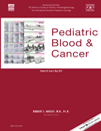The significance of serial histopathology in a residual mass for outcome of intermediate risk stage 3 neuroblastoma†
Conflict of interest: Nothing to declare.
Abstract
Background
To describe the serial histopathology of intermediate risk stage 3 neuroblastoma after chemotherapy, and correlate with residual mass at therapy completion and outcome.
Procedure
A retrospective review of intermediate risk stage 3 neuroblastoma patients treated 1989–2005 at Children's Hospital Los Angeles according to CCG 3881 or CCG 3961 protocols was performed, with central review of histopathology, radiology, and surgery.
Results
Eighteen patients treated per CCG 3881 (n = 9) or CCG 3961 (n = 9), with including 1 (n = 5), 2 (n = 9), ≥3 (n = 3), or unknown number (n = 1) of surgical procedures were included. At therapy completion, 10 patients had residual tumor: <10% original size (n = 3), >10% original size (n = 6) (5 MIBG avid; 4 with elevated catecholamines), and CT non-measurable MIBG avid tumor (n = 1). Post-chemotherapy histology showed tumor regression (n = 4); or maturation with (n = 6) or without (n = 2) Schwannian development. Histologic changes correlated with median tumor shrinkage of 80% (regressing tumors) and <25% (maturing tumors). Tumor size increased in one patient with maturing tumor and Schwannian development. Overall survival was 100%.
Conclusion
Post-chemotherapy histopathology of intermediate risk stage 3 neuroblastoma was characterized by regression or maturation. Persisting residual and maturing tumors were not associated with tumor progression, despite MIBG uptake and/or elevated catecholamines, supporting observation only. Histopathology should be obtained in future studies to confirm these findings, and guide length of chemotherapy. Pediatr Blood Cancer 2012; 58: 675–681. © 2011 Wiley Periodicals, Inc.




